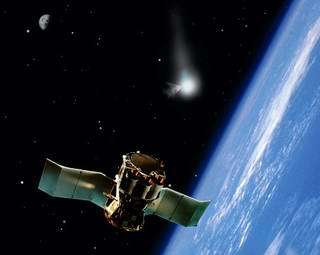Hibernating Spacecraft Awakens for Comet Impact Mission

The Submillimeter Wave Astronomy Satellite (SWAS) has been asleep on orbit for the past 11 months. SWAS operators placed it into hibernation after a highly successful 5.5-year mission highlighted by the discovery of a swarm of comets evaporating around an aging red giant star. Now, they have awakened SWAS again for the first-ever opportunity to study a comet on a collision course with a U.S. space probe.
SWAS will have a ringside seat for a probe-comet impact on July 4, 2005. Artwork Credit: NASA, B. Scott Kahler, David Aguilar
"We knew there was life left in SWAS," said SWAS Principal Investigator Gary Melnick (Harvard-Smithsonian Center for Astrophysics). "SWAS's ability to detect emission from water convinced us that we could contribute to the broader understanding of comets generated by this event. This once-in-a-lifetime event was just too tempting to pass up."
NASA's Deep Impact mission will rendezvous with Comet Tempel 1 at the end of June. Twenty-four hours before collision, on July 3rd, the flyby spacecraft will deploy a 39-inch long by 39-inch wide, 802-pound copper-reinforced impactor to strike the comet's nucleus. As the main Deep Impact spacecraft watches from a safe distance, the impactor will blast material out of the comet, excavating a football stadium-sized crater of pristine ice from the interior. SWAS will measure the abundance of water molecules as the icy comet debris vaporizes.
"Because a comet is composed mostly of ice and rock, water is the most abundant molecule released by a comet. Everything else vaporizing from the comet is measured relative to the amount of water," said Melnick. "Water is the gold standard for comets, so knowing how much water is being released per second is a very useful piece of information."
Current SWAS measurements indicate that Comet Tempel 1 is ejecting about 730 pounds of water per second, which is modest by cometary standards. Deep Impact mission designers specifically selected the target for this reason because the probe's mothership will have a better chance of surviving the flyby. SWAS will watch closely for any changes to the water production rate during and after the impact. Its measurements will help constrain the nature of the comet's nucleus, including its chemical makeup.
NASA and the SWAS team decided to reawaken the satellite because it offers several unique advantages for observing the impactor-comet collision. SWAS can determine the water production rate directly. It has a large field of view that encompasses both the comet nucleus and the surrounding envelope of vaporized gases known as the coma. And, it is above the atmosphere and unaffected by weather, allowing SWAS to monitor the comet almost continuously.
In early June, the satellite was powered up and its components successfully tested. SWAS will remain active through the end of August, watching Comet Tempel 1 for any long-term changes.
"It's gratifying that a satellite that has contributed so much during its lifetime has been given one more opportunity," said Melnick. "Helping to decipher the composition of material thought to be unchanged since the birth of our solar system seems like a great last act."
Headquartered in Cambridge, Mass., the Harvard-Smithsonian Center for Astrophysics (CfA) is a joint collaboration between the Smithsonian Astrophysical Observatory and the Harvard College Observatory. CfA scientists, organized into six research divisions, study the origin, evolution and ultimate fate of the universe.
Source: Harvard-Smithsonian Center for Astrophysics

















